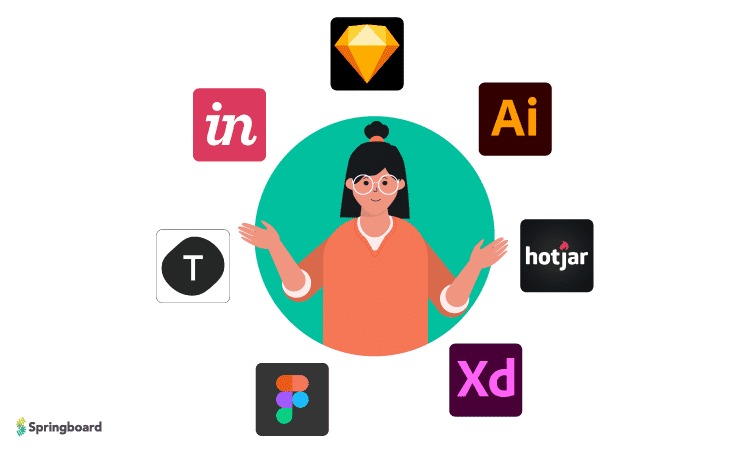Free UX Design Course
Dive into UX design with our free starter course. Transform your creative ideas into user-friendly solutions.
Almost every successful product or service has benefited from some form of user experience research, whether a company has hired a whole team of user researchers to conduct focus groups and user interviews, sent out a quick survey, or simply asked friends and family for their feedback.
And while UX research is itself a distinct profession that requires formal training, UX/UI designers should still familiarize themselves with common UX research methods if they want to up their game.
“Empathy is at the heart of design,” said Tim Brown, CEO of design firm IDEO. “Without understanding what others see, feel, and experience, design is a pointless task.”
The Interaction Design Foundation builds on that idea, encouraging designers to engage in UX research because:
- It helps them build products and services that are relevant to their users;
- It helps them create designs that are easy and pleasurable to use; and
- It helps them understand the return on investment of their designs
Understanding the different methodologies and insights that UX research offers can also improve collaboration and communication between designers and researchers, product managers, engineers. And, in the event that a UX designer doesn’t have access to a research team, they can take their own steps toward gaining insights into users’ behavior, motivations, pain points, and needs.
Related: What is UX Design?
What Are UX Research Methods?
User experience research serves many purposes, from identifying users’ needs and goals to understanding user behaviors, validating or debunking assumptions, pinpointing problems within a product or service, and coming up with potential solutions. In order to get into users’ heads and understand the user experience, researchers use a range of user research methods that generally fall into one of two categories: quantitative research and qualitative research.
Quantitative research methods, also known as quant research, typically concern numerical data. These methods try to identify what problems exist, where they exist, and how many users are affected by the issue. The goal of quantitative methods is to identify trends of statistical significance so that design teams can resolve problems as they arise, understand what’s working, and pivot if their assumptions are off base. Common quant research methods include analytics, surveys, A/B testing, and eye-tracking testing.
Qualitative research methods, also known as qual research, typically concern user behaviors, motivations, and attitudes. Where quant research tries to answer questions like where and how much, qualitative research attempts to shed light on why. The goal of qualitative research methods is to understand why a problem exists, how users think or feel about a product, service, or feature, and what possible solutions or improvements could be introduced. Common qualitative research methods include interviews, focus groups, open-ended surveys, diary studies, and usability testing.
Why Are UX Research Methods Important?
“If you want a great site, you’ve got to test,” said Steve Krug, author of Don’t Make Me Think: A Common Sense Approach to Web Usability. “After you’ve worked on a site for even a few weeks, you can’t see it freshly anymore. You know too much. The only way to find out if it really works is to test it.”
User testing, and, by extension, user research methods, are a crucial part of the design process. Without taking on user feedback, studying user behaviors, testing how a platform or app functions on different devices, observing how users interact with the user interface, and considering the possible use cases in different scenarios, it’s nearly impossible to measure customer satisfaction or to know if a product or service is actually working as intended.
There’s a high cost to building and launching products that either don’t work or no one needs. Glitchy services can frustrate users to the point of giving up. Difficult-to-use websites and storefronts can lead to a drop in sales and conversion. Platforms that fail to delight and make life easier for users risk losing their customers to a competitor. And if a product or service proves irrelevant, then an entire business can shutter. This is why user research is so important, according to UX professionals—UX research methods can help organizations identify weaknesses in their products, understand what users actually want, and avoid the pitfall of irrelevance. “To find ideas, find problems,” said Julie Zhuo, former VP of product design at Facebook. “To find problems, talk to people.”
Related Read: 10 Best UX Research Courses to Grow Your Skillset
Get To Know Other Design Students
Arin Soukoule
Design Experience Analyst at Accenture Interactive
Jeffrey Surban
UX Designer at Citi
Sinem Ozkaya
UX Designer at Microsoft
11 Essential UX Research Methods—and How To Use Them
There are dozens of methods that UX researchers use to better understand their users’ experience. Below are some of the more common qualitative and quantitative methods that are used by researchers. It’s not unusual for UX teams to use more than one method; in fact, qualitative and quantitative methods often complement each other and help paint a more nuanced and accurate picture of how users are experiencing a product or service, what they like about it, what’s not working, and possible fixes and improvements.
1. Card sorting
A qualitative method that attempts to get into users’ heads, card sorting presents users with a collection of words or images on cards and asks them to arrange them into categories or flows that make sense to them. For example, an e-commerce company might have research participants create a checkout flow so that they can see what users expect to see when they buy something online—the findings from such a study can then inform how a checkout page is designed.
2. Usability testing
This method is used by both qualitative and quantitative researchers because it is capable of collecting both qualitative and quantitative data. In the former, researchers can observe a research participant as they use a product, service, or prototype, asking them to narrate their experience and track where they might be running into issues. In the latter, researchers can record the number of users who are running into problems and pinpoint where issues are arising.
3. A/B testing
A quantitative method in which researchers offer multiple versions of a website, platform, or service, and analyze collected data on how users interact with each version. A/B testing can reveal whether one version is more useful than another and whether certain features influence conversion.
4. Focus groups
Typically involving six to nine research participants, focus groups give researchers an opportunity to measure how users feel about a product or service. Participants can be asked about their prior experiences with a product, what issues they’ve run into, and what attitudes they hold about a certain brand or company. This method also offers insights into what users want.
5. Interviews
One of the more open-ended forms of qualitative user research, interviews are a great exploration tool because they allow participants to offer in-depth and unrestricted responses, while giving researchers the opportunity to ask follow-up questions. While this can be a time-consuming process in terms of participant recruitment, time spent conducting the user interviews, and time spent analyzing the findings, this methodology can often be illuminating and give researchers a deep understanding of their users.
6. Behavioral research
Similar to usability testing, this method involves observing users to understand their behaviors, which in turn can help establish trends that designers can then factor into their work. Where participants might inadvertently say one thing and do another, behavioral observations allow research to actually see a participant interact with a product.
7. Diary studies
This method meets participants wherever they are. Instead of inviting participants into a lab for structured testing or interviews, diary studies ask participants to keep a log of their actions. For example, a ride-hailing company like Uber might ask participants to make a note of each time they travel—are they choosing public transport, hailing an Uber, calling a cab, walking, or driving their own car? What’s motivating the choice at that moment? These kinds of studies can often provide long-term insight into how and why people use a product or service.
8. Analytics
One of the most common forms of quantitative research, analytics covers a huge range of data collected from websites, apps, and platforms. One of the strengths of analytics is that they typically involve the data collected from a large number of participants, which makes it possible to see trends and issues of statistical significance. One of the most popular tools used in this form of research is Google Analytics, which can track data ranging from the number of site visitors to time spent on site, conversion rate, type of browser used, and referral links.
9. Expert review
This process involves bringing on an expert in UX/UI research and design who can go through a product and, using their own expertise and experience, identify areas that can be improved. The process can vary from person to person, and expert reviews typically require only one “expert” to give feedback.
10. Eye movement tracking
As the name suggests, eye movement tracking uses hardware and software to track where a users’ eyes are moving across a screen to better understand where users’ attention is drawn and how designers can prioritize content on a page in order to maximize views.
11. User personas
Also referred to as profiles, this is a method in which researchers use findings from other forms of research to create fictional representations of users, assigning them traits, attributes, and a backstory that designers and collaborators can keep in mind as they build products.
What Is the Role of UX Research Methods in a Designer’s Life?
User experience research is foundational in any UX designer’s process. Whether a designer is conducting research themselves or working off the findings of a UX research team, research methodologies help shed light on what users want and need, which in turn informs design decisions big and small. Whether it’s figuring out how a website’s navigation can be improved, understanding what strengths a company has over its competitor’s products or finding ways to make a product or service easier and more intuitive to use, research methods take out the guesswork and provide designers with the evidence they need to make informed decisions that potentially affect large swaths of the population.
“Usability plays a much wider role in our lives than most people realize,” according to UX research consultant Thomas Tullis. “It’s not just about using a website, a piece of software, or the latest technology. Usability is about setting up a tent, relighting a furnace to heat a home, trying to figure out a tax form, or driving an unfamiliar rental car. Usability impacts everyone, every day. It cuts across cultures, age, gender, and economic class.”
This post was written by Tracey Lien.
Since you’re here
If you want to work in design, you can. It’s that simple. With our UX Bootcamp, we’ll help you launch your design career in 9 months or less. Browse our free UX salary guide to see what you could be making






